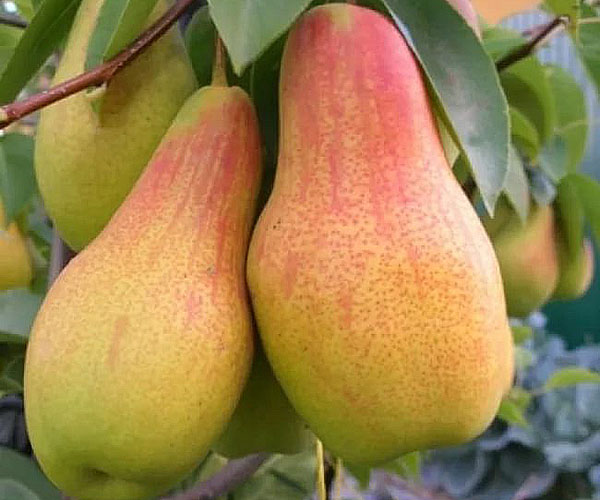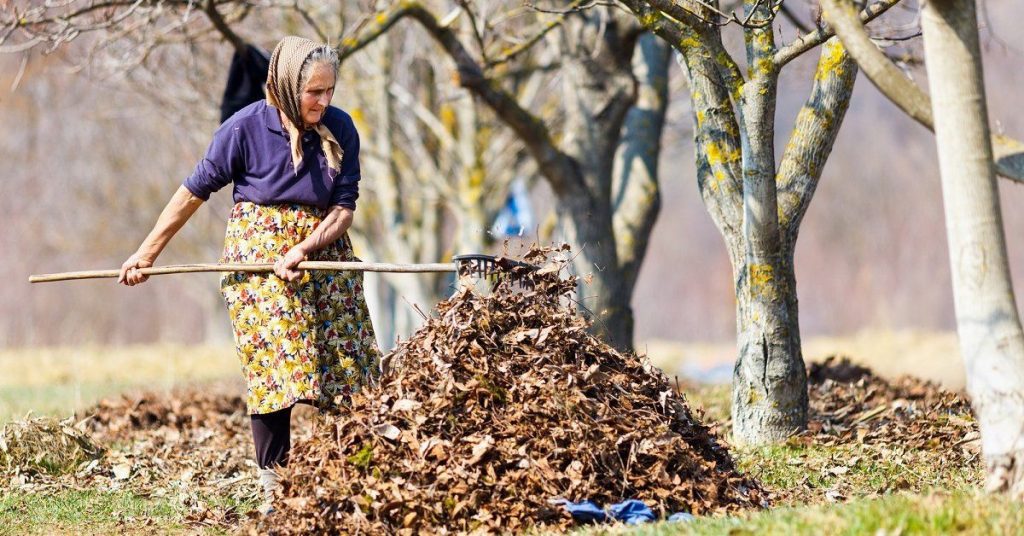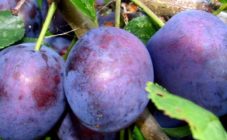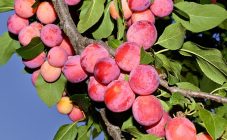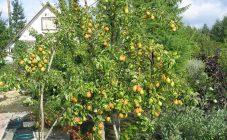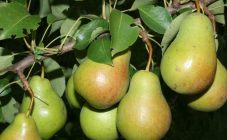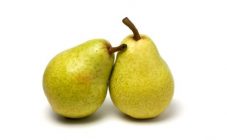Pear variety Forest beauty is considered autumn, grown in Armenia, Russia, Moldova, Ukraine, Estonia and Central Asia. The pear fruit tree was accidentally discovered by a traveler in a forest about 200 years ago in Belgium. When a Belgian scientist first began to grow this pear using seeds, it began to spread widely throughout Eurasia.
The Forest Beauty has other names: Alexandrina, Marie-Louise. In Russia, it is called the Oily tree.
This pear differs from others in its excellent qualities, so the breeders took it as a basis and, by crossing, bred more than 30 varieties of new pears.
The most common varieties of Forest Beauty: pear Northern Beauty, Russian Beauty, Lada, Michurinskaya, Altai, Samara, Bashkir, Dubovskaya early, Marble, Small, Orlovskaya, Moskovskaya, Elena, Sweet dessert.
Specifications
The forest beauty pear is perhaps one of the most frost-resistant, because it can withstand frosts down to -45 degrees and below! The tree is not afraid of spring frosts, flowers and buds calmly endure a cold snap up to 10 degrees.
The pear tree is not very large, up to 5 meters in height. Such pears usually have a crown that resembles a pyramid. The leaves have a light green or bright green tint, themselves are not very large, dense, small denticles along the edges. Petioles are thin, long. The bark is brown with a slight reddish tint. The branches are massive and thick, arched, the bark on the branches is dark red.
The pear blooms beautifully, with small, pinkish-white flowers. The older the branch, the more flowers it has. Fruits ripen in mid and late August. Begins to bear fruit in 1-2 years after planting.
Pear fruits are ovoid, light green or light yellow, slightly speckled. On the one hand, the sun shone there the most, there is a not too bright blush. The skin is thin, the bones are large. The pulp of the fruit is very tender and tasty, sweet, with a slight, subtle sourness, like a cream. The weight of one pear is approximately ± 140 g.
Description of pear fruits Forest beauty makes you imagine the perfect pear. And this is almost true.
The pear can self-pollinate. If it grows alone, then about 70% of the inflorescences are pollinated. But if a pollinator grows nearby, fruiting will be very abundant. To make the harvest happy, it is advised to plant next to such varieties of pears as Lyubimitsa Klappa, Josephine Mechelinskaya, Williams, Limonka, Bessemyanka.
But experienced gardeners note that by increasing yields, it becomes harder to cope with pear storage. Pears are stored for only 2 months, subject to good ventilation and maintaining a constant temperature - 0 ... + 2 degrees. After all, the Forest Beauty has a thin skin and the flesh itself is very soft. Accordingly, it is not stored for a long time. Therefore, even a self-pollinated pear gives a good harvest, quite sufficient for personal needs.
In addition to the fact that the Forest Beauty is tasty, it is also healthy - the content of micro- and macroelements, vitamins makes it an irreplaceable dietary product.
Agrotechnics
Saplings are planted in spring (before green leaves appear) and in autumn (before frost appears).The pit is prepared in advance - 3-4 weeks before the planned planting. The depth should be at least 50-60 cm, diameter - 100-120 cm.
You need to pay attention to the composition of the soil - if it is clayey, add peat or sand, and if there is a lot of sand at the bottom of the pit, you need to add clay mixed with peat or rotted compost.
Before installing a seedling in the pit, a peg is driven into it in order to tie up a still fragile tree.
To prevent the roots of a fruit tree from drying out (especially during spring planting), they are dipped in a thick clay mixture.
After all this, the tree is set in a hole, carefully, slowly, the roots are sprinkled with earth, then everything is tamped. To retain water, a shallow hole is made around the trunk of the plant.
To make it easier for the tree to take root, you can mulch it. Sawdust is poured around the trunk in a good layer, so that a slide is obtained. This will help keep moisture in the soil for a long time and prevent weed growth.
Further care involves regular watering (if there is no rain) once a week for a month after planting. 2-3 buckets of water are poured under each tree (bucket - 10 liters). Then you only need to water once a month or as needed. Intensive watering for 2-3 months after planting is needed in order for the pear to take root.
No earlier than 1-2 years after planting, you can fertilize the pear. Fertilizers with a mineral composition (superphosphate, potassium salt) can be applied every year. And organic fertilizers (humus, peat, compost, eggshells, ash) only once every 2-3 years.
When the tree grows up and gets stronger (about 2-4 years after planting), the grass need not be weeded. It is only necessary to regularly mow the lawn in the pear garden and pull out large weeds. And in order to prevent the invasion of insects on the pear, the tree trunk must be whitewashed with a thick solution of lime every spring.
Since the Forest Beauty is not afraid of frost, there is no need to wrap the trunk for the winter.
Pruning is required in autumn and spring. Old, diseased, dry branches need to be cut. When the seedling reaches the age of 2-3 years, you can begin to form a crown - the central trunk is cut off every year (by 10-15 cm). The correct crown provides good ventilation between the branches, sufficient lighting.
In the fall, immediately after the entire crop has been harvested, the pear must be well watered. Great attention should be paid to watering in the spring, during flowering and at the end of summer - when fruiting begins.
For the prevention of diseases, you need to immediately remove the fallen leaves and fruits from under the pear. Fallen leaves are either burned or taken out of the garden. In the spring, while there are no buds and leaves, the tree should be treated with a Bordeaux mixture. The Bordeaux mixture contains copper sulfate, which prevents fungi from overcoming the tree. This liquid can abundantly moisten the trunk of a pear - then both the tree and the earth will be saturated with iron.
In order to notice the larvae of insects or themselves in the ground in time, every spring you need to carefully dig up the soil near the pear and carefully study it for the presence of pests. If any are found, it is necessary to treat the land and tree with insecticides. You need to use these drugs with extreme caution and strictly according to the instructions, as they are very toxic.
Often the owners themselves are to blame for the pear disease, who do not pay due attention to the processing of garden tools. Untreated secateurs can be a source of infection. They should always be disinfected before pruning. If you do not handle the tool, you can infect all the trees in the garden.A bacterial burn very often develops as a result of such actions.
Pros and cons of the variety
Advantages of the Forest Beauty:
- High resistance to subzero temperatures.
- The long life span is 40-60 years.
- Unpretentiousness in terms of care.
- Does not require any special soil - it grows almost everywhere. It takes root in both wet and dry ground.
- Resistant to pests and major diseases.
- Does not die in drought.
- Good, bountiful harvest.
- Excellent taste - the highest category.
- Excellent presentation. Outwardly, pears are beautiful, even, slightly oily.
- Simultaneous ripening of fruits.
- They tolerate the road well.
Disadvantages of the Forest Beauty:
- Short shelf life after ripening.
- Special conditions are required for storage.
- Sun Sensitivity - When there is a lack of sunlight, the yield is reduced.
- High susceptibility to fungal disease. The scab too often infects the tree, the fruits deteriorate and become unusable. Scab develops when summers are rainy and not sunny, or when the weather is too changeable.
- During flowering, many flowers and ovaries fall off.
- Unpleasant smell of overripe pears.
In general, most gardeners believe that the benefits of the variety outweigh its disadvantages. Therefore, this type of pear tree is very popular among domestic gardeners. Growing such a fruit tree is not difficult. And the harvest will be a pleasant addition to the table of any gourmet.
